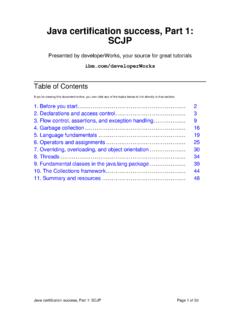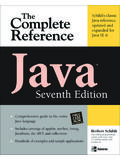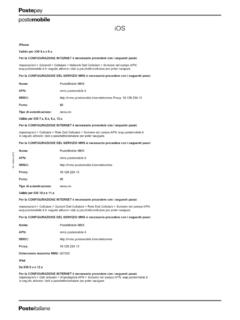Transcription of Introduction to Java threads - Free Java Tutorials & …
1 Introduction to java threadsPresented by developerWorks, your source for great of ContentsIf you're viewing this document online, you can click any of the topics below to link directly to that About this thread A thread 's threads Sharing access to Synchronization Additional thread API Wrapup and to java threadsPage 1 of 30 Section 1. About this tutorialWhat is this tutorial about?This tutorial explores the basics of threads -- what they are, why they are useful, and how toget started writing simple programs that use will also explore the basic building blocks of more sophisticated threading applications --how to exchange data between threads , how to control threads , and how threads cancommunicate with each I take this tutorial?This tutorial is for java programmers who have a good working knowledge of the Javalanguage, but who have limited experience with multithreading or the completion of this tutorial, you should be able to write simple programs that usethreads.
2 You should also be able to read and understand programs that use threads instraightforward the authorBrian Goetz is a regular columnist on thedeveloperWorksJava technology zone and hasbeen a professional software developer for the past 15 years. He is a Principal Consultant atQuiotix, a software development and consulting firm located in Los Altos, Brian'spublished and upcoming articlesin popular industry Brian by developerWorks, your source for great tutorialsPage 2 of 30 Introduction to java threadsSection 2. thread basicsWhat are threads ?Nearly every operating system supports the concept of processes -- independently runningprograms that are isolated from each other to some is a facility to allow multiple activities to coexist within a single process. Mostmodern operating systems support threads , and the concept of threads has been around invarious forms for many years.
3 java is the first mainstream programming language toexplicitly include threading within the language itself, rather than treating threading as afacility of the underlying operating are sometimes referred to aslightweight processes. Like processes, threads areindependent, concurrent paths of execution through a program, and each thread has its ownstack, its own program counter, and its own local variables. However, threads within aprocess are less insulated from each other than separate processes are. They sharememory, file handles, and other per-process process can support multiple threads , which appear to execute simultaneously andasynchronously to each other. Multiple threads within a process share the same memoryaddress space, which means they have access to the same variables and objects, and theyallocate objects from the same heap. While this makes it easy for threads to shareinformation with each other, you must take care to ensure that they do not interfere with otherthreads in the same java thread facility and API is deceptively simple.
4 However, writing complex programsthat use threading effectively is not quite as simple. Because multiple threads coexist in thesame memory space and share the same variables, you must take care to ensure that yourthreads don't interfere with each java program uses threadsEvery java program has at least one thread -- the main thread . When a java program starts,the JVM creates the main thread and calls the program'smain()method within that JVM also creates other threads that are mostly invisible to you -- for example, threadsassociated with garbage collection, object finalization, and other JVM housekeeping facilities create threads too, such as the AWT (Abstract Windowing Toolkit) or SwingUI toolkits, servlet containers, application servers, and RMI (Remote Method Invocation).Why use threads ?There are many reasons to use threads in your java programs.
5 If you use Swing, servlets,RMI, or Enterprise JavaBeans (EJB) technology, you may already be using threads withoutrealizing of the reasons for using threads are that they can help to:Presented by developerWorks, your source for great to java threadsPage 3 of 30 Make the UI more responsive Take advantage of multiprocessor systems Simplify modeling Perform asynchronous or background processingMore responsive UIEvent-driven UI toolkits, such as AWT and Swing, have an event thread that processes UIevents such as keystrokes and mouse and Swing programs attach event listeners to UI objects. These listeners are notifiedwhen a specific event occurs, such as a button being clicked. Event listeners are called fromwithin the AWT event an event listener were to perform a lengthy task, such as checking spelling in a largedocument, the event thread would be busy running the spelling checker, and thus would notbe able to process additional UI events until the event listener completed.
6 This would makethe program appear to freeze, which is disconcerting to the avoid stalling the UI, the event listener should hand off long tasks to another thread sothat the AWT thread can continue processing UI events (including requests to cancel thelong-running task being performed) while the task is in advantage of multiprocessor systemsMultiprocessor (MP) systems are much more common than they used to be. Once they werefound only in large data centers and scientific computing facilities. Now many low-end serversystems -- and even some desktop systems -- have multiple operating systems, including Linux, Solaris, and Windows NT/2000, can takeadvantage of multiple processors and schedule threads to execute on any basic unit of scheduling is generally the thread ; if a program has only one active thread ,it can only run on one processor at a time.
7 If a program has multiple active threads , thenmultiple threads may be scheduled at once. In a well-designed program, using multiplethreads can improve program throughput and of modelingIn some cases, using threads can make your programs simpler to write and a simulation application, where you simulate the interaction between multipleentities. Giving each entity its own thread can greatly simplify many simulation and example where it is convenient to use separate threads to simplify a program iswhen an application has multiple independent event-driven components. for example, anapplication might have a component that counts down the number of seconds since by developerWorks, your source for great tutorialsPage 4 of 30 Introduction to java threadsevent and updates a display on the screen. Rather than having a main loop check the timeperiodically and update the display, it is much simpler -- and less error-prone -- to have athread that does nothing but sleep until a certain amount of time has elapsed and thenupdate the on-screen counter.
8 This way the main thread doesn't need to worry about thetimer at or background processingServer applications get their input from remote sources, such as sockets. When you readfrom a socket, if there is no data currently available, the call ()will block until data is a single-threaded program were to read from the socket, and the entity on the other end ofthe socket were never to send any data, the program would simply wait forever, and no otherprocessing would get done. On the other hand, the program could poll the socket to see ifdata was available, but this is often undesirable for performance , instead, you created a thread to read from the socket, the main thread could perform othertasks while the other thread waited for input from the socket. You can even create multiplethreads so you can read from multiple sockets at once. In this way, you are notified quicklywhen data is available (because the waiting thread is awakened) without having to pollfrequently to check if data is available.
9 The code to wait on a socket using threads is alsomuch simpler and less error-prone than polling would , but sometimes riskyWhile the java thread facility is very easy to use, there are several risks you should try toavoid when you create multithreaded multiple threads access the same data item, such as a static field, an instance field ofa globally accessible object, or a shared collection, you need to make sure that theycoordinate their access to the data so that both see a consistent view of the data and neithersteps on the other's changes. The java language provides two keywords for this purpose:synchronizedandvolatile. We will explore the use and meaning of these keywordslater in this accessing variables from more than one thread , you must ensure that the access isproperly synchronized. For simple variables, it may be enough to declare the variablevolatile, but in most situations, you will need to use you are going to use synchronization to protect access to shared variables, you must makesure to use iteverywherein your program where the variable is 't overdo itWhile threads can greatly simplify many types of applications, overuse of threads can behazardous to your program's performance and its maintainability.
10 threads consumeresources. Therefore, there is a limit on how many threads you can create without degradingPresented by developerWorks, your source for great to java threadsPage 5 of particular, using multiple threads willnotmake a CPU-bound program run any faster on asingle-processor : Using a thread for timing and a thread to doworkThe following example uses two threads , one for timing and one to do actual work. The mainthread calculates prime numbers using a very straightforward it starts, it creates and starts a timer thread , which will sleep for ten seconds, and thenset a flag that the main thread will check. After ten seconds, the main thread will stop. Notethat the shared flag is ** CalculatePrimes -- calculate as many primes as we can in ten seconds*/public class CalculatePrimes extends thread {public static final int MAX_PRIMES = 1000000;public static final int TEN_SECONDS = 10000;public volatile boolean finished = false;public void run() {int[] primes = new int[MAX_PRIMES];int count = 0;for (int i=2; count<MAX_PRIMES; i++) {// Check to see if the timer has expiredif (finished) {break;}boolean prime = true;for (int j=0; j<count; j++) {if (i % primes[j] == 0) {prime = false;break;}}if (prime) {primes[count++] = i; ("Found prime: " + i);}}}public static void main(String[] args) {CalculatePrimes calculator = new CalculatePrimes(); ();try { (TEN_SECONDS).}}}




